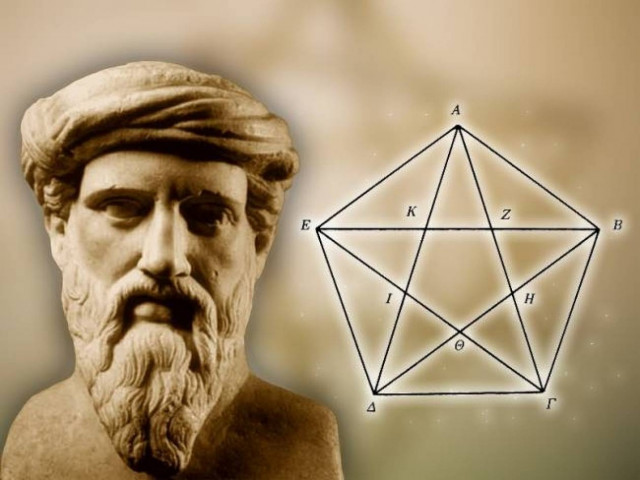The pentacle in Pythagorean philosophy
The influence of Pythagoras to Plato, Aristotle and to the Hellenistic times.

The journey of the pentagram (pentacle) over the centuries is due mainly to the teaching of the Ancient Greek philosopher, Pythagoras of Samos.
In the school of Pythagoras in Croton Magna Grecia which flourished in the 4th century BC, Pythagorean cosmological system passed in the works of Plato and part to in the works of Aristotle, and remained alive during the Hellenistic period and the Roman era through its descendants.
Indicative of influence is that in the early 20th century, Whitehead, one of the founders of modern logic, reproduce the ancient references which attribute to Pythagoras the invention of the concept of philosophy along with the description of nature as a world or an ordered set, the discovery of the sphericity of the Earth, the development of the theory of proportions in Mathematics, the identification of the five regular polyhedra and the discovery of the numerical proportions in which subject the basic musical chords.
In the philosophy of Pythagoras prominently positioned are the triangular numbers, Tetractys (if we construct a triangle starting with one and adding consecutive integers, the first 4 numbers form the shape that the Pythagoreans call Tetraktys, quartet, as the number 4 is represented also in the three sides of the equilateral triangle), the perfect number 10 (the first four integers have a sum of 10 1 +2 +3 +4 = 10), and finally, number 5 which is also significant.
The pentagon - and therefore the pentacle - connected with the Pythagorean Theorem (through the construction and proof of a pentagon inscribed in a circle), although in the Pentagon there are no right angles. If in a regular pentagon we pull diagonals from each vertex, we create a pentacle. The two diagonals of the same peak create an isosceles triangle. The isosceles triangles formed are consistent with the "golden ratio", the discovery of which is attributed to Pythagoras. Also, the pentacle inside the pentagon forms 10 angles, i.e. the number of Pythagorean perfect number.
Furthermore, indicative of the specificity of the number 5 in ancient tradition is that the Eleusinian mysteries were held every five years, and at the School of Pythagoras was a 5-year trial period. Candidate members, called "omakooi" forced into vow of silence during the testing period, in which had to silently listen to the voice of Pythagoras. Also, the regular polyhedra which were taught at the Academy of Plato and the work of Euclid are 5 and they mapped in five cosmic elements, fire, earth, air, water and ether. In Plato's Timaeus, when the Creator is presented to organize the body of the universe, manufactures four elementary bodies of two rectangular triangles, which combine to form the five regular solids.
The importance of the numbers in the Pythagorean philosophy was also mentioned by Aristotle. The Pythagoreans began observing the numerical proportions of musical chords or harmonies and found more points of correlation between the numbers and the world so they concluded that "the entire universe is harmony and numbers". This idea of a network of relationships between music, mathematics and celestial phenomena, summarized in the concept of the music of the spheres which is a key principle of Pythagorean thought.
Later, in the era of neo-Pythagorean the symbolism of the pentagram was enriched. The neo-Pythagorean Spefsippos, on his project "On Pythagorean Numbers", includes a treatise on the 5 platonic solids which are "attributed to the cosmic elements", while in the Pythagorean memorandum which was preserved by Diogenes Laertes from Alexander Polyistora, was stated that "virtue is harmony, as is health, all the good and god himself. That is why the universe is structured harmoniously". In that period, the Pythagorean use of the pentagram is recognized as a symbol of inner health. Each vertex of Pentacles is matched by a secular element; water, earth, concept (platonic), warmth (caress of the sun, heat), air. In Pythagoras memorandum, is indicated the meaning of "warm", because "warmth is predominant (in the celestial bodies) and is the cause of life". The role of heat as a sign of sulfur reminds the dominant place of fire in Stoic thought.
Thus, the initial letters of the concepts corresponding in pentacle form the word 'health'. The Pythagorean use of the pentagram was associated during this period with the symbol of inner health. As a word, the word 'health' is also found in earlier times and refers to the homonymous ancient Greek deity.
Therefore, the ancient pentegrammon as "the star shape, formed by the Pythagoreans via engaging triangular shape, often called pentacle", according to the "Great Dictionary of the Greek language" of Henry G. Liddell and Robert Scott, was central to the development of mathematics and Pythagorean philosophy. The connection with the occult starts gradually from the Roman period, when there was a revival of Pythagorean philosophy which was blended with astrology and rituals of the East and supported by the Middle Ages alchemists of the time. Finally, reaches to a distortion in modern times, when most people attribute to the pentacle a dark content of the worship of Satan, the development of Freemasonry and the Jewish occult.









.jpg)














